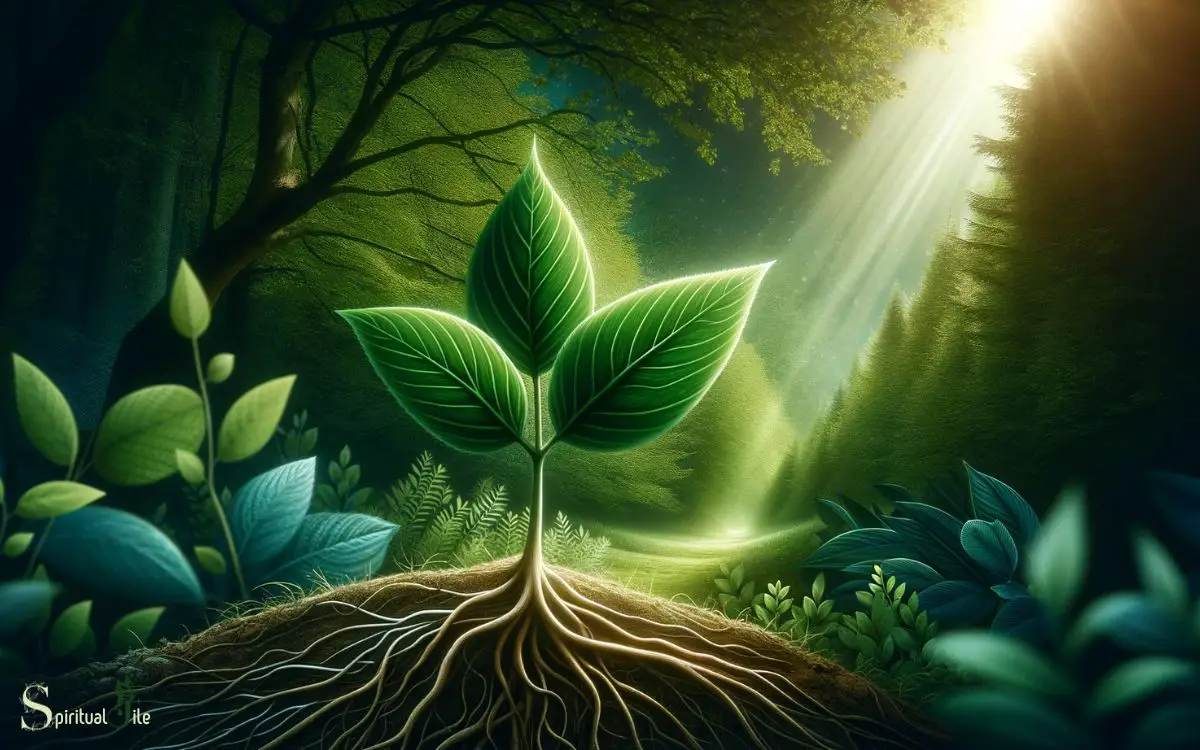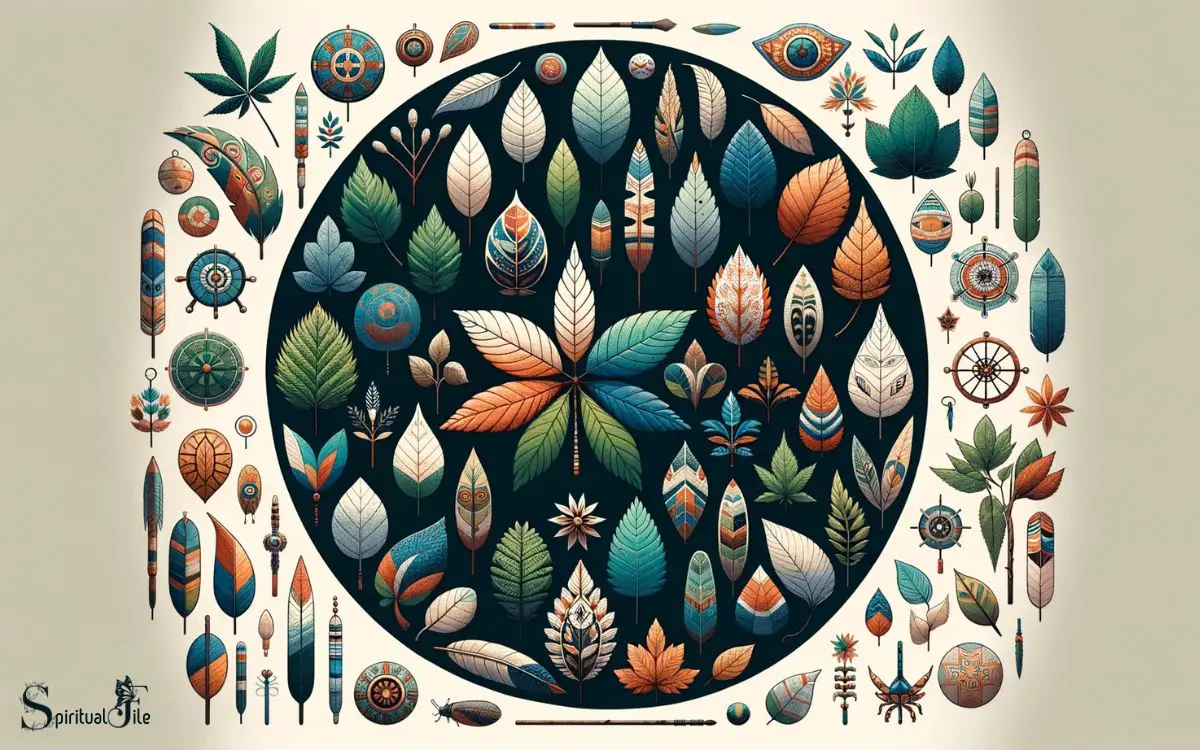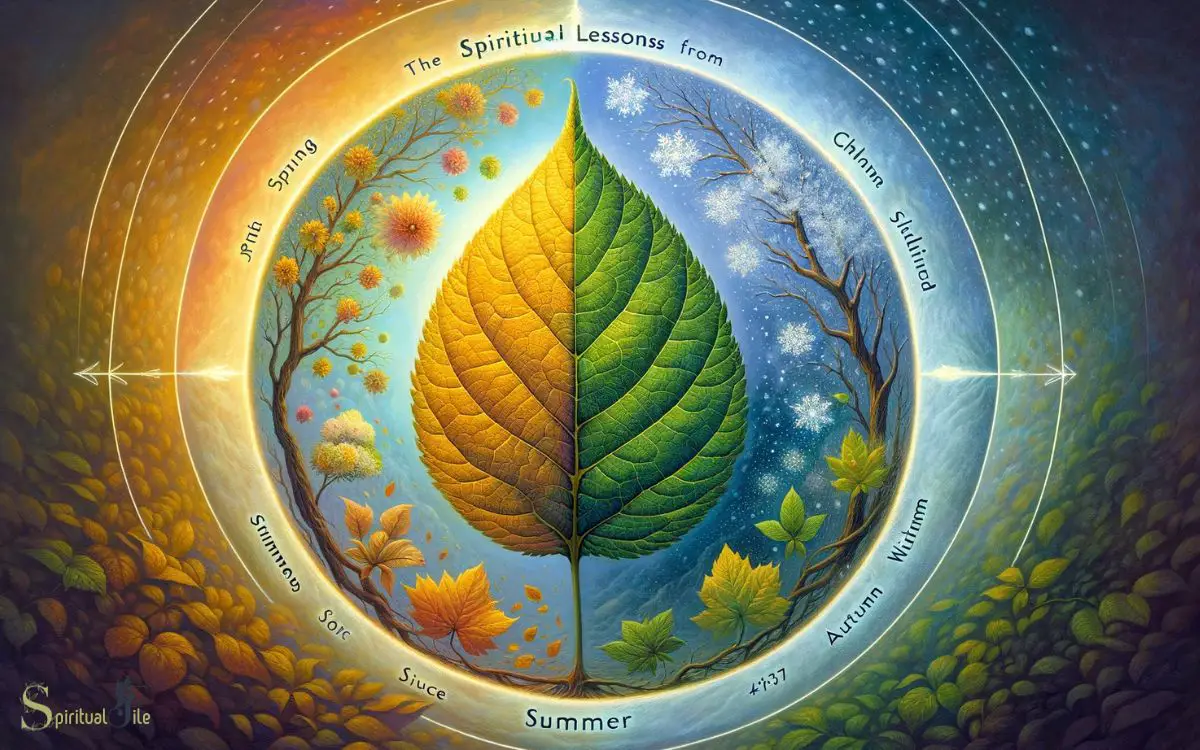What Does a Leaf Symbolize Spiritually? Growth
The leaf is a powerful spiritual symbol representing growth, renewal, life’s transient nature, and the cycles of life and death. In various spiritual contexts, leaves symbolize hope, healing, and the connection between the physical and spiritual realms.
Spiritually, leaves are often seen as symbols of growth, renewal, and transience. Just as a leaf grows and thrives on a tree, it can represent personal growth and development. Leaves also die in the fall and regrow in the spring, symbolizing rebirth and new beginnings.
Additionally, the life cycle of a leaf serves as a reminder of the impermanence of life. For example, in Buddhism, the Bodhi tree leaf is significant as it represents the ultimate knowledge gained when Buddha attained enlightenment.
The leaf serves as a spiritual emblem, evoking a sense of wonder and reflection on the ephemeral beauty and cyclical nature of existence.

Key Takeaway
Symbol of Growth and Renewal

The leaf serves as a symbol of growth and renewal in various spiritual and cultural traditions. Across different belief systems, it represents the cycle of life, death, and rebirth.
In Christianity, the leaf is often associated with the concept of spiritual growth, as individuals are encouraged to grow in faith and bear spiritual fruit.
In Buddhism, the Bodhi leaf symbolizes the stages of enlightenment and the potential for inner transformation.
Similarly, in many indigenous cultures, the leaf is seen as a representation of the interconnectedness of all living beings and the continuous cycle of life.
The renewal of leaves in springtime further reinforces this symbolism, reminding believers of the opportunity for personal growth and rejuvenation.
Connection to Nature and Earth

The connection between leaves and nature is profound, as leaves are a direct gift from the Earth. Their presence symbolizes the intricate interdependence between all living beings and the natural world.
In exploring the spiritual symbolism of leaves, it becomes evident that they serve as a reminder of the renewing and regenerative powers of nature.
Leaf as Earth’s Gift
A symbol of nature’s abundance and vitality, the leaf represents Earth’s gift to humanity, fostering a profound connection to the natural world.
Leaves play a pivotal role in the Earth’s ecosystem, converting sunlight into energy through photosynthesis and releasing oxygen essential for life.
Their intricate structures and diverse forms reflect the richness and diversity of the natural world, serving as a reminder of the interconnectedness of all living beings.
Leaves symbolize the cycle of life, growth, and renewal, embodying the Earth’s enduring resilience and capacity for regeneration.
As Earth’s gift, leaves inspire reverence for the environment and encourage a deeper appreciation of the planet’s resources.
They remind us of our responsibility to nurture and protect the Earth, fostering a harmonious relationship with nature for the benefit of present and future generations.
Symbol of Renewal
An integral symbol of renewal and a profound connection to nature and Earth, the leaf embodies the cycle of life and growth with its intricate structures and diverse forms.
Leaves symbolize the renewal of life, as they go through the process of photosynthesis, converting sunlight into energy and releasing oxygen, essential for life on Earth.
The table below illustrates the symbolic significance of leaves in representing renewal and connection to nature and Earth.
| Symbolic Representation | Emotional Connection |
|---|---|
| Growth and Rebirth | Hope and Fresh Beginnings |
| Connection to Nature | Peace and Harmony |
| Earth’s Renewing Energy | Vitality and Sustainability |
Leaves, through their seasonal changes and vital role in sustaining life, serve as a reminder of the interconnectedness between all living beings and the Earth, fostering a sense of renewal and harmony.
Representation of Vitality and Life

Symbolizing vitality and life, a leaf embodies the essence of growth and renewal in many spiritual traditions.
The representation of vitality and life through a leaf holds deep spiritual significance, reflecting the interconnectedness of all living beings and the cyclical nature of existence.
This symbolism is evident in various spiritual beliefs and practices, where the leaf is revered as a powerful symbol of life force and resilience.
Here’s how the representation of vitality and life is manifested through a leaf:
Renewal: The regenerative nature of leaves mirrors the continuous cycle of birth, growth, and rejuvenation.
Connection to Nature: Leaves symbolize the interconnectedness between all living beings and the nourishing power of the natural world.
Life Force: In spiritual contexts, leaves are often associated with the vital life force that sustains all living things, emphasizing the preciousness and fragility of life.
Significance in Different Cultural Traditions

The significance of leaves in different cultural traditions is multifaceted. In many religious rituals, leaves are used to symbolize purity, renewal, and growth.
Additionally, leaves are often connected to nature’s cycles, representing the changing seasons and the cycle of life and death.
Moreover, across various cultures, leaves are seen as a powerful representation of life and growth.
Symbolism in Religious Rituals
In religious rituals, leaves hold significant symbolic meaning across diverse cultural traditions. They are often used to convey profound messages and represent various spiritual concepts.
Here are a few examples of the symbolism of leaves in religious rituals:
- Hinduism: In Hindu religious rituals, leaves, particularly from the sacred fig tree, are used as offerings to deities. They symbolize purity, fertility, and the interconnectedness of all living beings.
- Shintoism: In Shinto rituals, leaves, especially sakaki leaves, are considered sacred and are used to purify the sacred space. They symbolize purity, renewal, and the presence of divine spirits.
- Christianity: In some Christian traditions, leaves, such as palm leaves, are used in religious ceremonies, symbolizing victory, peace, and the triumph of good over evil.
These examples illustrate the rich symbolism of leaves in religious rituals, reflecting the deep spiritual significance they hold in different cultural traditions.
Connection to Nature’s Cycles
Leaves’ connection to nature’s cycles holds significant spiritual importance in different cultural traditions, reflecting the intertwined relationship between humanity and the natural world.
In various cultures, leaves symbolize the cyclical nature of life, death, and rebirth. For example, in many indigenous traditions, the changing colors of leaves are seen as a reflection of the Earth’s natural rhythms and are often integrated into seasonal ceremonies and rituals.
In Japanese culture, the falling of cherry blossom leaves, known as ‘sakura’, is celebrated as a reminder of the transience of life and the beauty of impermanence.
Similarly, in Celtic traditions, the turning of the leaves in autumn is viewed as a symbol of the cyclical nature of life and the interconnectedness of all living things.
This deep spiritual connection to nature’s cycles emphasizes the profound impact of the changing seasons on human consciousness and spiritual growth, transitioning seamlessly into the subsequent section about representing life and growth.
Representing Life and Growth
A leaf symbolizes life and growth spiritually, holding significant importance in various cultural traditions.
Across different cultures, the leaf represents the following:
- Renewal and Rebirth: In many cultures, the emergence of new leaves in spring symbolizes renewal, regeneration, and the cyclical nature of life. It signifies the opportunity for a fresh start and the potential for growth and transformation.
- Connection to the Earth: Leaves are seen as a connection to the earth and the natural world, representing the interconnectedness of all living things. They are often associated with grounding, stability, and the sustenance provided by the environment.
- Symbol of Fertility and Prosperity: In some traditions, leaves are linked to fertility, abundance, and prosperity. They are believed to bring good fortune, wealth, and a bountiful harvest, symbolizing the flourishing of life and the fulfillment of potential.
Reflection of Transience and Impermanence

Symbolizing the impermanence of life, the leaf holds deep spiritual significance across various cultures and belief systems.
Just as a leaf transitions through the seasons, from bud to bloom to wither, it serves as a poignant reminder of the transitory nature of existence.
This symbolism is reflected in the following aspects:
| Aspect | Description |
|---|---|
| Change | The leaf’s changing colors and eventual fall mirrors the cycle of life and death. |
| Impermanence | Its short lifespan signifies the fleeting nature of life and the importance of living in the present. |
| Renewal | Despite its eventual decay, the leaf’s decomposition enriches the soil, signifying the potential for regeneration. |
| Acceptance | Embracing the inevitable cycle of change and decay fosters spiritual growth and acceptance of life’s impermanence. |
The leaf, therefore, serves as a profound symbol of embracing the transient and evolving nature of life.
Spiritual Lessons From the Changing Seasons

The changing seasons offer profound spiritual lessons, reflecting the cycle of life and emphasizing the importance of embracing impermanence.
This natural phenomenon teaches us valuable spiritual insights:
- Impermanence: The seasons remind us that change is inevitable and that nothing in life is permanent. Embracing this impermanence can help us cultivate resilience and adaptability.
- Renewal and Rebirth: Just as nature sheds its old leaves and blooms anew, the changing seasons symbolize the opportunity for personal growth, renewal, and transformation. It encourages us to let go of the past and embrace new beginnings.
- Harmony and Balance: Each season brings its unique beauty and purpose, teaching us the significance of finding balance and harmony in our lives. It encourages us to appreciate the present moment and find peace in the ebb and flow of life.
Can the Spiritual Symbolism of Flowers Also Apply to Leaves?
Yes, the spiritual symbolism of flowers can also apply to leaves. In many cultures, leaves represent growth, healing, and regeneration, similar to what flowers symbolize spiritual life. Leaves are often associated with the cycle of life and the connection between the physical and spiritual worlds.
Healing and Restoration in Spiritual Practices

Drawing upon the insights gained from the changing seasons, spiritual practices emphasize the importance of healing and restoration as essential components of personal growth and inner transformation.
In spiritual contexts, healing involves the process of addressing emotional, mental, and physical wounds, while restoration pertains to the renewal and rejuvenation of the spirit.
Through practices such as meditation, prayer, and mindfulness, individuals seek to heal from past traumas, release negative energies, and restore their connection to the divine and to themselves.
Spiritual teachings often underscore the interconnectedness of mind, body, and spirit, emphasizing the necessity of holistic healing for overall well-being.
Conclusion
The leaf holds significant spiritual symbolism as a representation of growth, renewal, vitality, and connection to nature across various cultural traditions.
It serves as a powerful reminder of the transient and impermanent nature of life and imparts valuable spiritual lessons through the changing seasons.
Additionally, the leaf is revered for its healing and restorative properties in various spiritual practices, making it a truly profound and sacred symbol in the spiritual realm.






